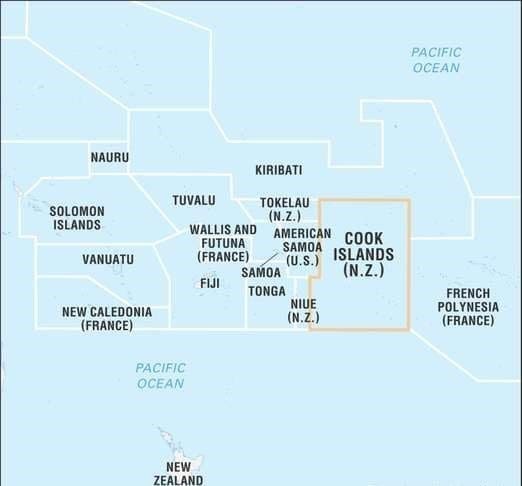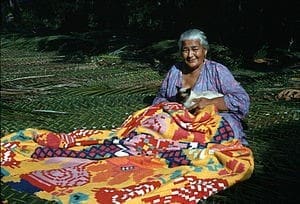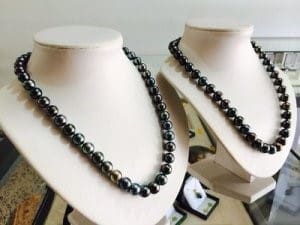Cook Islands, self-governing island state in free association with New Zealand, located in the South Pacific Ocean. Its 15 small atolls and islands have a total land area comparable to that of a medium-sized city, but they are spread over about 770,000 square miles (2,000,000 square km) of sea an area nearly as large as Greenland. Niue, the westernmost of the islands, is an administratively separate state. The administrative seat is Avarua, on the island of Rarotonga. Area (land only) 91.4 square miles (236.7 square km).
Ethnic groups and languages
With the exception of the inhabitants of isolated Pukapuka, who are of predominantly Samoan and Tongan descent, almost all Cook Islanders have mixed Polynesian ancestry. Intermarriage with European, Chinese, and African settlers was common in the early 19th century.
There are two main indigenous Polynesian languages, one for the island of Pukapuka and the other (with dialectal variations) for all other islands. The latter, known as Cook Islands Maori, is an official language, as is English.
Religion
Christian denominations account for nearly all religious affiliation. Just over half of the population belongs to the Cook Islands Christian (Congregational) Church. Roman Catholicism, Anglicanism, Seventh-day Adventism, and Bahāʾī have smaller numbers of adherents.
Cultural Life
The government plays an active role in cultural life, particularly in the sponsorship of song and dance festivals for which the islands are renowned. A small library and museum in Avarua provide additional cultural attractions. Owing to tourism and intensive interaction with neighbouring industrialized nations, much international (generally Western) culture has been incorporated into daily life.
Nevertheless, traditional ceremonies, such as that celebrating the first haircut of the favourite son in a family, are as vibrant as ever. The islands’ distinctive cuisine draws on the traditions of Europe, China, Fiji, and Tahiti. Christian tradition, some of it a legacy of the English Victorian era, is strongly manifest, and modern American-derived evangelistic services and rituals are common.
The major national holiday is Constitution Day, which usually gives rise to a 10-day celebration. A Tiare (“Gardenia”) Festival, a parade of floats, and a series of song and dance competitions fill the annual calendar of festivities.
The broadcast media are privately owned, although the government issues licenses. Radio programming is available in English and Maori. Much of the television programming comes from New Zealand. The only daily newspaper, formerly government-owned, was privatized in 1989; other newspapers are published weekly or fortnightly.
Weaving
The outer islands produce traditional weaving of mats, basketware and hats. Particularly fine examples of rito hats are worn by women to church. They are made from the uncurled immature fibre of the coconut palm and are of very high quality. The Polynesian equivalent of Panama hats, they are highly valued and are keenly sought by Polynesian visitors from Tahiti.
Often, they are decorated with hatbands made of minuscule pupu shells that are painted and stitched on by hand. Although pupu are found on other islands the collection and use of them in decorative work has become a speciality of Mangaia. The weaving of rito is a speciality of the northern islands, Manihiki, Rakahanga and Penrhyn.
Art
- Graphic Arts. The islands are known for a textile art called tivaevae, practiced by women, which combines appliqué and embroidery. Tivaevae decorates bedspreads and cushion covers. Flower art is popular in the form of ei (necklaces) and ei katu (tiaras). Jewelry made from black pearls is another specialty. Other traditional arts and crafts include woven pandanus mats, baskets, purses, and fans.
Tivaevae- A major art form in the Cook Islands is tivaevae. This is, in essence, the art of handmade Island scenery patchwork quilts. Introduced by the wives of missionaries in the 19th century, the craft grew into a communal activity, which is probably one of the main reasons for its popularity.
- Performance Arts. The islands are known for music (primarily fast, complex drumming) and dance, in particular the fast, hip-swinging tamure, which is performed in traditional costumes consisting of grass skirts and headbands. Many of these performances are held for tourists on so-called Island Nights at hotels. They also are staged during the annual Dance Week every April and during Constitution Week in the summer.
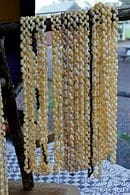
Shell necklaces

Stone sculpture

Dance
Traditional dress is a distinctive feature of island life
Like much else on the islands, dress is casual and modest. Both men and women wear wrap-around pieces of material called ‘pareu’ (sarong) around the home, and women sometimes tie them nicely to wear out on a special occasion.
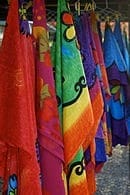
Colourful pareu
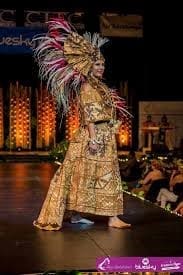
Traditional costumes

Traditional music costume
Unique wooden carvings, finely woven hats and black pearl jewellery
Perhaps most widely recognised are the communally sewn ‘tivaevae’ – colourful and intricate quilts that women piece together in groups. These beautiful quilt designs that take many hours to produce often feature flowers, plants, butterflies, and sea-life.
The beauty and charm of the Cooks is matched by the friendliness of the people who think nothing at all of offering a lift, having a chat with you on the beach or extending an invitation to dinner. An important reason why people love holidaying here.
Carving
This wooden late eighteenth or early nineteenth century carved figure escaped emasculation. Only one other comparable example is known apart from this one in the British Museum. Woodcarving is a common art form in the Cook Islands. The proximity of islands in the southern group helped produce a homogeneous style of carving but that had special developments in each island.
Rarotonga is known for its fisherman’s gods and staff-gods, Atiu for its wooden seats, Mitiaro, Mauke and Atiu for mace and slab gods and Mangaia for its ceremonial adzes. Most of the original wood carvings were either spirited away by early European collectors or were burned in large numbers by missionaries.
Today, carving is no longer the major art form with the same spiritual and cultural emphasis given to it by the Maori in New Zealand. However, there are continual efforts to interest young people in their heritage and some good work is being turned out under the guidance of older carvers.
Atiu, in particular, has a strong tradition of crafts both in carving and local fibre arts such as tapa. Mangaia is the source of many fine adzes carved in a distinctive, idiosyncratic style with the so-called double-k design. Mangaia also produces food pounders carved from the heavy calcite found in its extensive limestone caves.
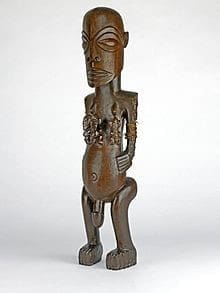
Carving

Cook islands baha’i necklaces

Black pearl jewellery
Article by- Sneha Savla

